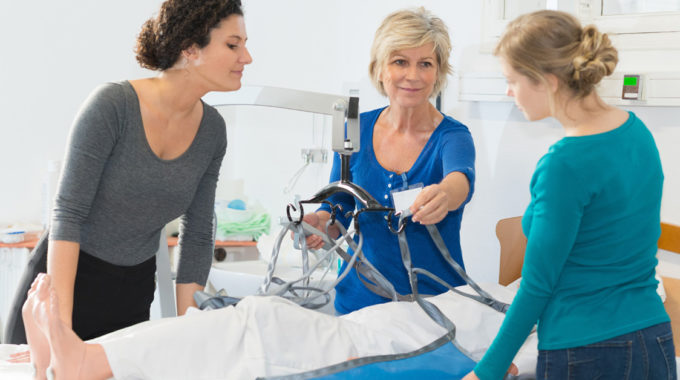
The Best Setting for Rehab After a Knee Replacement: Inpatient, Home, or Outpatient
Rehab after surgery decreases pain and improves outcomes. This is especially true for orthopedic surgeries such as knee and hip replacements. The right amount of rehab is even associated with lower risks of chronic opioid use. In addition to receiving orthopedic rehabilitation with the right timing and frequency, people have been wondering if Americans are receiving rehab in the right setting. For patients receiving total knee replacement, is it better to receive rehab while staying at a skilled nursing facility, at home, or driving to and from a facility?
What Is The Difference Between Inpatient, Outpatient, And Community-Based Rehab?
These terms only refer to the setting in which patients receive rehab. With inpatient rehab, patients sleep at a facility and receive rehab during the day. The facility may be a rehab center, nursing home, skilled nursing facility, etc. Outpatient rehab means the patient travels to and from the rehab center or a physical therapy clinic. The rehab provider may be the same facility, or it may be a therapy practice that only sees outpatients. Finally, community-based rehab means the therapists travel to the patient’s home. Community-based rehab is usually delivered by Medicare-certified home health agencies, but there are physical therapy practices that specialize in home visits as well.
The Rising Economic Burden of Total Knee Replacements
In the United States, the rate of total knee replacements has increased 1100% (elevenfold) since 1980.1 The greater need for these expensive surgeries puts an obvious strain on healthcare budgets. One bright spot in this situation is the increased availability of home health rehab. Many of these patients are seniors, and in decades past, more of them had to spend weeks in a nursing home or rehab facility after their hospital discharge. Home health rehab helps keep the costs down. Medicare pays 100% with no out-of-pocket costs to seniors.
Where Are People Receiving Rehab After Knee Replacements?
Today, many of these seniors with total knee replacements go straight home from the hospital. They receive nursing and physical therapy through home visits. This costs Medicare thousands of dollars less per surgery. However, the percentage of people receiving home health versus inpatient rehab varies widely by surgeon, hospital, and country. In Australia, nearly 40% of privately-insured patients with knee replacements receive inpatient rehab.1 In the U.S. and Switzerland, inpatient rehab following this surgery occurs at high rates. On the other hand, in Canada and the U.K., inpatient rehab following this procedure is relatively uncommon. If the U.S. handled knee replacement rehab the same as Canada and the U.K., healthcare costs could be much lower, but would this be in the best interest of patients?
Is Inpatient Rehab Better Than Home Health Rehab?
Inpatient rehab certainly costs thousands more than home health rehab. It’s easy to assume that what costs more must be better. For total knee replacement rehab, this turns out to not be the case. A large meta-analysis combining the results of 18 studies and including 1,739 patients concluded the following: in-home physical therapy achieves faster improvements in range of motion compared to center-based physical therapy, and center-based rehab has no outcome advantages over in-home rehab.3
Is Outpatient Rehab Better Than Home Health Rehab?
It’s also a common belief that effective rehabilitation must require heavy equipment and special tools. Home health physical therapists may be able to deliver some modalities in the home, but they largely rely on weights, bands, and bodyweight exercises – a category sometimes referred to as “low-tech rehab.” However, it turns out the assumptions are wrong. Megan Warren and colleagues reviewed the records of 109 patients discharged from a hospital after total knee replacements.4 After two months, they compared the outcomes of patients discharged to home health with those discharged to outpatient physical therapy. They received the same number of physical therapy visits, and the functional outcomes were not statistically different.
Setting Does Not Affect Outcomes of Rehab Following a Total Knee Replacement
This evidence suggests that patients can expect similar outcomes whether they receive total knee replacement as an inpatient, through home health, or by visiting an outpatient clinic. They are simply different programs serving different audiences. Inpatient rehab will be best for people who will not be able to take care of themselves at home. Home health rehab will be better for people who need the assistance of another person or special equipment to leave the home, and repeated trips away from the home would prove too burdensome. Outpatient rehab will cost the least for Medicare and will be best for those people who can visit a center or clinic multiple times per week without much trouble.
References
- Maradit Kremers H, Larson D, Crowson C, et al. Prevalence of total hip and knee replacements in the United States. J Bone Joint Surg Am. 2015; 97 (17): 1386-1397.
- Hart A, Bergeron S, Epure L, et al. Comparison of US and Canadian perioperative outcomes and hospital efficiency after total hip and knee arthroplasty. JAMA Surg. 2015; 150 (10): 990-998.
- Artz N, Elvers KT, Lowe CM, Sackley C, Jepson P, Beswick AD. Effectiveness of physiotherapy exercise following total knee replacement: systematic review and meta-analysis. BMC Musculoskeletal Disorders. 2015 Dec;16(1):15.
- Warren M, Kozik J, Cook J, Prefontaine P, Ganley K. A comparative study to determine functional and clinical outcome differences between patients receiving outpatient direct physical therapy versus home physical therapy followed by outpatient physical therapy after total knee arthroplasty. Orthopaedic Nursing. 2016 Nov 1;35(6):382-90.






